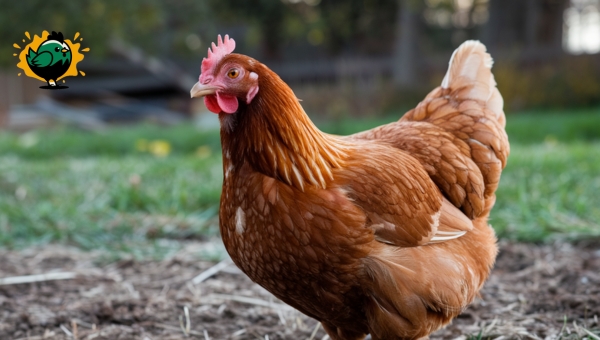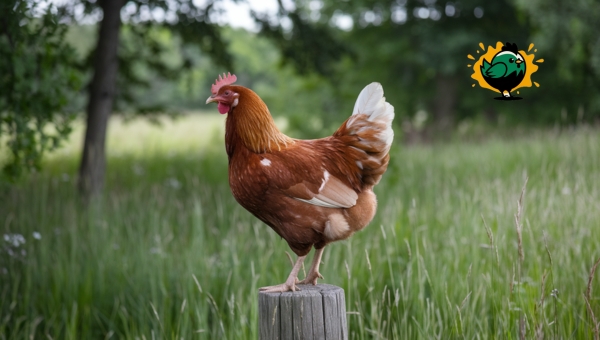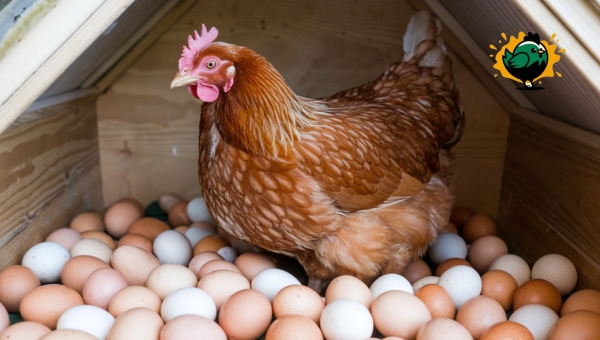Rhode Island Red Chicken | Your Path to Perfect Poultry

Imagine a backyard filled with the lively clucks and gentle rustling of Rhode Island Red chickens. These birds, with their rich history and captivating traits, are a testament to the art of selective breeding. Originating in the mid-1800s, they’ve become a staple in many farms due to their resilience and egg-laying prowess.
Rhode Island Red chickens are not just a practical choice for poultry enthusiasts; they’re a story of heritage and reliability. As you delve into this article, you’ll uncover the secrets behind their enduring popularity and learn how to raise these remarkable birds for both eggs and companionship.
History Of Rhode Island Red Chicken
The Rhode Island Red chicken traces its origins to the mid-1800s in Rhode Island and Massachusetts. This breed emerged through selective breeding, combining birds such as the Malay and Brown Leghorn.

Known for its hardiness and impressive egg-laying capabilities, the Rhode Island Red quickly gained popularity among farmers and poultry enthusiasts. By 1904, the breed was officially recognized by the American Poultry Association.
Its significance is underscored by its designation as the state bird of Rhode Island, with commemorative monuments erected in the 1920s and 1950s. Moreover, the Rhode Island Red has played a crucial role in the development of modern hybrid chickens, thanks to its desirable traits and adaptability to various environments.
Physical Characteristics Of Rhode Island Red Chicken
Rhode Island Red chickens are renowned for their striking and robust appearance, making them a standout breed.

Their features not only contribute to their beauty but also to their functionality in various settings. Let’s dive into the specifics of their size, feather color, and comb type to understand what makes them unique.
Size And Weight
Rhode Island Reds are medium to large-sized chickens. Roosters generally weigh around 8.5 pounds (3.9 kg), while hens usually tip the scales at approximately 6.5 pounds (2.9 kg). This size contributes to their dual-purpose nature, as they are suitable for both egg production and meat.
Feather Color
The feathers of Rhode Island Reds are primarily a rich, lustrous red, with some exhibiting darker maroon shades, especially near the tail. This vibrant plumage not only adds to their visual appeal but also offers some protection against harsh weather conditions.
Comb Type
Rhode Island Red chickens can have either a single or rose comb, both of which are vividly red. These combs complement their overall striking appearance and play a role in temperature regulation. The presence of either comb type is a defining characteristic of this breed.
Also Read: Chicken Grit Guide | Boost Your Flock’s Health
Temperament & Behavior Of Rhode Island Red Chicken
Understanding the temperament and behavior of Rhode Island Red chickens is essential for anyone considering adding them to their flock. This breed is renowned for its unique blend of characteristics that make them both fascinating and practical to keep.
Here’s a detailed look at their temperament and behavior:
- Friendly Nature: Rhode Island Reds are known for being generally friendly and approachable. They often interact well with humans, making them a popular choice for backyard flocks. Their curious nature means they are not shy and will often investigate their surroundings or new additions to their environment.
- Assertive Behavior: Despite their friendliness, they can exhibit an assertive streak, especially within the flock hierarchy. This assertiveness is more noticeable in confined spaces where they may establish dominance over other breeds. It’s important to monitor their interactions to ensure harmony within a mixed flock.
- Energetic Foragers: These chickens are active foragers, thriving in environments where they can roam and scratch for food. This behavior not only keeps them physically fit but also reduces the need for supplemental feeding, as they are adept at finding insects and other natural food sources.
- Adaptability: Rhode Island Reds adapt well to various living conditions. They are hardy birds that can thrive in different climates, making them a versatile option for many poultry keepers.
- Sociability: While they can be independent, Rhode Island Reds enjoy the company of their flock mates. They often engage in social behaviors, which can include dust bathing and communal roosting, helping to strengthen the bonds within the group.
- Vigilance: Known for their alertness, these chickens are attentive to their surroundings, which can be beneficial for spotting potential threats. This trait, coupled with their assertiveness, can help ward off predators, although it is always advised to ensure adequate protection.
By understanding these aspects of their temperament and behavior, you can create an environment that maximizes their potential and ensures their well-being.
Egg Production Of Rhode Island Red Chicken
Rhode Island Red chickens are renowned for their impressive egg production capabilities. These birds are prized for their ability to lay a significant number of eggs, making them a popular choice among poultry keepers. Understanding their egg-laying capacity and implementing best practices can ensure optimal output from this breed.

Quantity And Quality
Rhode Island Reds are known to be prolific layers, with hens usually producing around 5 to 7 eggs each week. This amounts to approximately 310 eggs during their first laying season, providing a reliable and steady supply. The eggs are typically brown and known for their excellent quality, boasting strong shells and rich yolks that many find desirable.
Best Practices For Optimal Production
To achieve the best possible egg production with Rhode Island Reds, consider the following practices:
- Diet: Ensure a balanced diet with high-quality layer feed rich in calcium and protein.
- Lighting: Maintain adequate lighting to simulate longer daylight hours, which encourages laying.
- Space: Provide ample space for the chickens to move freely, reducing stress and promoting health.
- Health: Regular health checks and vaccinations can prevent diseases that impact egg production.
Care And Feeding
Caring for Rhode Island Red chickens involves understanding their specific needs to keep them thriving. From nutrition to housing, each aspect plays a crucial role in their well-being. Let’s explore the essential nutritional requirements and suitable housing arrangements for this popular breed.
Nutrition Requirements
Rhode Island Reds thrive on a balanced diet that meets all their dietary needs. High-quality layer feed is essential, as it provides the necessary proteins and nutrients vital for their health.
Additionally, offering supplements like oyster shells ensures they receive adequate calcium, which is crucial for strong eggshell production. Access to clean water is also a must to keep them hydrated and healthy.
Housing Needs
Providing appropriate housing is key to ensuring the well-being of your Rhode Island Reds. A spacious coop, equipped with good ventilation, keeps them comfortable and reduces stress.
It’s important to have a secure enclosure to protect them from predators. Allowing them access to outdoor space for roaming and foraging helps maintain their physical and mental health.
Also Read: Sapphire Gem Chicken | The Surprising Ups and Downs!
Health Considerations
When caring for Rhode Island Red chickens, understanding their health considerations is important. These chickens are generally hardy, but like all breeds, they can face specific health challenges. Here, we delve into common health issues and offer preventative strategies to keep your flock thriving.
Common Health Issues
Rhode Island Red chickens, while robust, can encounter a few health problems:
- Respiratory Problems: These can arise from poor ventilation or damp conditions.
- Parasites: Mites and lice are common external parasites that can affect their well-being.
- Egg Binding: This occurs when a hen cannot pass an egg, requiring immediate attention.
Preventative Measures
Ensuring the health of your Rhode Island Reds involves several proactive steps:
- Hygiene Practices: Regular cleaning of their coop minimizes the risk of infections.
- Balanced Diet: Providing a nutritious diet supports their immune system and overall health.
- Regular Vet Checks: Routine veterinary check-ups help catch potential issues early on.
Uses And Benefits
Keeping Rhode Island Red chickens offers several advantages for both small-scale and larger poultry enthusiasts:
- Dual-purpose Utility: These chickens are excellent for both meat and egg production, providing a robust source of food for families and small farms.
- Hardiness: Rhode Island Reds are known for their adaptability to different climates, making them a popular choice in diverse regions.
- Low Maintenance: They are good foragers, which means they can supplement their diet by roaming and finding their own food, reducing feeding costs.
- Friendly Disposition: Generally sociable with humans, they make a great addition to any backyard or farm setting, especially for those new to raising chickens.
- Prolific Egg Layers: Known for their high egg production, they offer a steady supply of fresh eggs, which is a significant benefit for household consumption or small-scale selling.
Conclusion
The Rhode Island Red chicken stands out as a versatile and beneficial breed for both novice and experienced poultry keepers. Its rich history, coupled with its robust physical characteristics and excellent egg production, makes it a top choice for many.
The breed’s friendly disposition and adaptability to various environments further enhance its appeal. By understanding their care, feeding, and health needs, keepers can ensure their Rhode Island Reds thrive and provide continued benefits.
For those considering or already keeping this remarkable breed, the Rhode Island Red offers a reliable and rewarding poultry experience. If you enjoyed learning about the Rhode Island Red chicken, explore more informative articles on our site!
